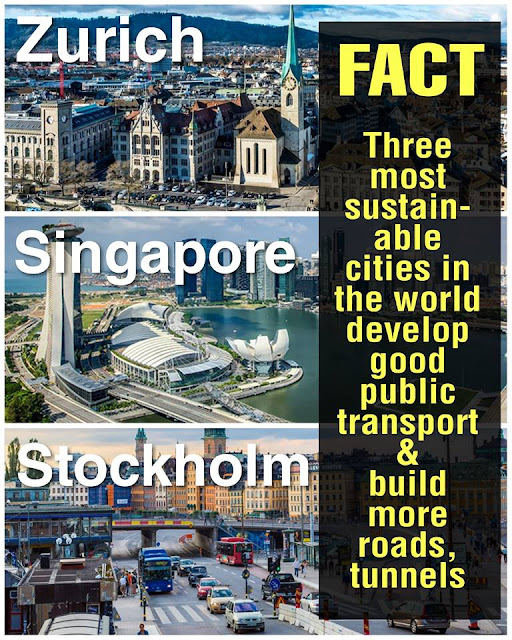Do you know that Zurich, Singapore, and Stockholm are top sustainable cities in the world?
They have traffic jam too, like Penang. To solve the traffic problem, these 3 cities develop better public transport and build new roads simultaneously.
They have traffic jam too, like Penang. To solve the traffic problem, these 3 cities develop better public transport and build new roads simultaneously.
Zurich, Switzerland
Zurich has buses, trams, boats, and trains as modes of public transport. RM804 mil allocated by their government in 2017 to expand the northern bypass.
Last year, the Swiss parliament set aside RM7.4 bil for their “Fund for the Special Financing of Road Transport” for road expansion projects.
Switzerland has 239 tunnels with combined length of 251 km. The Galgenbuck Tunnel and Belchen Tunnel are currently being built at the cost of RM934 mil and RM2.05 bil respectively. In the pipeline is a new RM8.2 bil tunnel for cars, located next to the current Gotthard road tunnel.
Last year, the Swiss parliament set aside RM7.4 bil for their “Fund for the Special Financing of Road Transport” for road expansion projects.
Switzerland has 239 tunnels with combined length of 251 km. The Galgenbuck Tunnel and Belchen Tunnel are currently being built at the cost of RM934 mil and RM2.05 bil respectively. In the pipeline is a new RM8.2 bil tunnel for cars, located next to the current Gotthard road tunnel.
Singapore
Singapore’s public transport comprises MRT, LRT, monorail, extensive bus network, fleets of regulated taxi, electric-car sharing service, and developing self-driving buses and cars.
Currently, Singapore has at least 13 on-going road construction projects, estimated cost of RM33.56 bil.
Singapore has 5 road tunnels with the latest being the 1.4 kilometres undersea Sentosa Gateway Tunnel, opened last year, built at a cost of about RM600 mil.
Currently, Singapore has at least 13 on-going road construction projects, estimated cost of RM33.56 bil.
Singapore has 5 road tunnels with the latest being the 1.4 kilometres undersea Sentosa Gateway Tunnel, opened last year, built at a cost of about RM600 mil.
Stockholm, Sweden
Stockholm has buses, underground trains, commuter trains, trams, and ferries.
Two major road projects are being carried out in Stockholm county. The 20 km Tvärförbindelse Södertörn project at the south is in the planning phase, with the estimated cost of RM2.26 bil.
The Stockholm bypass project, estimated to cost RM14.7 bil started construction in 2015. 18 km of the 21 km bypass are road tunnel.
All these 3 cities have used "drill and blast" method for tunneling work.
Two major road projects are being carried out in Stockholm county. The 20 km Tvärförbindelse Södertörn project at the south is in the planning phase, with the estimated cost of RM2.26 bil.
The Stockholm bypass project, estimated to cost RM14.7 bil started construction in 2015. 18 km of the 21 km bypass are road tunnel.
All these 3 cities have used "drill and blast" method for tunneling work.
Penang, Malaysia
No two cities are exactly alike. We cannot blindly copy all their transport policy. Nonetheless, I am glad that Penang Transport Master Plan (PTMP) uses strategy similar to the 3 cities.
Before PTMP, Penang has initiated subsidised and free bus programmes. The Central Area Transit and Bridge Express Shuttle Transit were started in 2009 and 2011 respectively.
This year RM15 million is allocated for the Congestion Alleviation Transport free bus initiative that covers twelve routes on both the mainland and island. And recently, a RM90 million fund is set aside to improve the ferry services.
Besides expanding public transportation, consultation and traffic realignment have also been studied and conducted by the two local councils with the involvement of traffic experts from Universiti Sains Malaysia.
PTMP's first phase is to build LRT and the Pan-Island Link 1 expressway, with about 50% of road tunnel. We have to strive to be a sustainable city, learning from top existing ones.
Before PTMP, Penang has initiated subsidised and free bus programmes. The Central Area Transit and Bridge Express Shuttle Transit were started in 2009 and 2011 respectively.
This year RM15 million is allocated for the Congestion Alleviation Transport free bus initiative that covers twelve routes on both the mainland and island. And recently, a RM90 million fund is set aside to improve the ferry services.
Besides expanding public transportation, consultation and traffic realignment have also been studied and conducted by the two local councils with the involvement of traffic experts from Universiti Sains Malaysia.
PTMP's first phase is to build LRT and the Pan-Island Link 1 expressway, with about 50% of road tunnel. We have to strive to be a sustainable city, learning from top existing ones.
